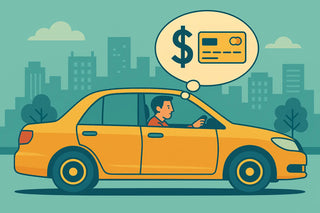For millions of Americans, having a car payment feels as normal as paying rent or buying groceries. But have you ever stopped to wonder why? The truth is, the car payments culture didn’t happen by accident—it’s the result of decades of consumer habits, clever marketing, easy credit, and the deeply rooted idea that driving a new car equals success.
In this post, we’ll break down how car payments became a normal part of life for so many Americans—and what you can do to break free if you want your money to work for you instead.
The Rise of Car Payments Culture
Back in the day, people paid cash for cars or bought used vehicles outright. But things started to shift after World War II, when car manufacturers and lenders realized they could sell more cars by offering easy credit.
Fast forward to today:
-
The average new car payment is $738 per month (2024 data).
-
The average loan term is now 70 months—almost six years.
-
Many buyers trade in their cars every few years, rolling old debt into new loans.
This cycle traps many Americans in a never-ending loop of payments. It’s so common that it feels normal—but is it really?
Why Do People Accept Car Payments as Normal?
There are a few key reasons:
1. Cars Are a Status Symbol
For decades, advertising has linked cars with freedom, status, and identity. Driving the latest model feels like proof you’re “doing well”—even if you’re paying interest to prove it.
2. Easy Financing Feels Pain-Free
Car dealerships often emphasize the monthly payment, not the total cost. It’s easy to say yes to a $700 payment when the sticker shock of $40,000+ is hidden behind low down payments and extended terms.
| Purchase Price | Down Payment | Loan Term | Monthly Payment |
|---|---|---|---|
| $35,000 | $2,000 | 72 months | ~$550/month |
| $50,000 | $5,000 | 84 months | ~$675/month |
When the focus stays on the payment, buyers overlook how much interest they’re really paying.
3. Keeping Up With the Joneses
The car payments culture feeds on comparison. If everyone in your neighborhood drives a new car, it feels normal to do the same—even if it means stretching your budget.
4. The Normalization of Debt
In the U.S., debt is a way of life: credit cards, student loans, personal loans—and car payments. Many people see debt as a financial tool, not a burden.
If you’re exploring all the ways debt affects your finances, read this related post: What Increases Your Total Loan Balance?
How Much Are Car Payments Really Costing You?
Let’s look at a quick example:
-
Car Price: $40,000
-
Loan Term: 72 months
-
Interest Rate: 6%
By the time you’re done paying, you could spend over $46,000—and your car will have lost significant value.
If you trade it in after 3 years, you may still owe thousands more than the car is worth. That’s negative equity, and it keeps the payments cycle alive.
Car Payments vs. Building Wealth
Financially smart people understand a simple truth: Cars depreciate—investments appreciate.
Think about it: What if you invested your car payment instead?
| Monthly Car Payment | Invested for 10 Years | Estimated Total at 7% Return |
|---|---|---|
| $500 | 10 years | ~$86,000 |
| $700 | 10 years | ~$120,000 |
| $800 | 10 years | ~$138,000 |
Owning a reliable used car and putting that monthly payment into an index fund could build a healthy chunk of wealth over time.
Run the numbers yourself with this compound interest calculator.
Breaking Free From the Car Payment Trap
If you’re tired of the payments cycle, here are smart steps you can take:
1. Drive Your Car Longer
One of the simplest ways to avoid car payments? Keep your current car until it truly needs replacing. Many modern cars easily last 150,000–200,000 miles with proper care.
2. Buy Used—Smartly
A 3–5-year-old car has already taken the biggest depreciation hit but can still run like new.
3. Save Ahead for Your Next Car
Use a separate savings account to build up cash for your next car purchase. Even paying half in cash reduces the amount you’ll finance—and the interest you’ll pay.
4. Reframe Your Status Symbols
Financially wise families know that a paid-off car feels better than impressing the neighbors. Want proof? Many financially smart grandparents mastered this mindset—choosing security over status.
Real-Life Example Table
| Buyer | Car | Total Cost After Interest | Value After 5 Years | Outcome |
|---|---|---|---|---|
| Sarah | $35,000 SUV | $40,500 | $18,000 | Still owes $5k |
| John | $15,000 used sedan | $15,900 | $7,000 | Paid off, no debt |
| Lisa | No car payment, drives old car | $0 | $2,000 | Investing $500/month instead |
FAQ: Car Payments Culture
Q1: Is having a car payment bad?
Not necessarily, but it can limit your financial flexibility. The key is making sure your car payment doesn’t eat up too much of your income.
Q2: What percentage of income should go to a car?
Experts suggest spending no more than 15% of your take-home pay on all car expenses (payment, insurance, gas, maintenance).
Q3: Should I pay off my car early?
Paying off your car early saves on interest and frees up cash for other goals—like building your retirement fund.
Q4: What if I can’t afford to pay cash for a car?
Start with a reliable used car that fits your budget. Then, save aggressively for your next one to break the payments cycle.
Final Thoughts
Car payments culture feels normal because it’s everywhere. But just because it’s common doesn’t mean it’s good for your financial future.
By understanding how the cycle works, asking tough questions, and planning ahead, you can break free from car payments—and use that money to build wealth instead.
Your future self will thank you.
